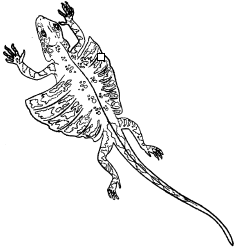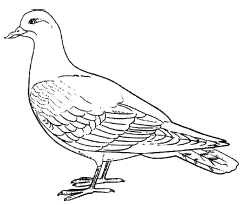Diversity in Living Organisms - Test Papers
CBSE Test Paper 01
Chapter 07 Diversity in Living Organism
A plant has woody stem and its leaves show reticulate venation? (1)
- Monocot
- Gymnosperms.
- Pteridophyta
- Dicot
Which of the following is a monocot? (1)
- Mango
- Mustard
- Carrot
- Wheat
The number of legs in a cockroach is (1)
- 6
- six pairs
- 4
- four pairs
Karl Von Linne was involved with which branch of science? (1)
- Physiology
- Taxonomy
- Morphology
- Medicine
Match the following with correct response.
Column A Column B (1) Amphibians (A) Eggs with tough covering (2) Reptiles (B) Viviparous (3) Aves (C) Egg laying (4) Mammals (D) Lay eggs in water - 1-B, 2-D, 3-A, 4-C
- 1-C, 2-B, 3-D, 4-A
- 1-A, 2-C, 3-B, 4-D
- 1-D, 2-A, 3-C, 4-B
What is hierarchy of categories? (1)
What is Linnaean hierarchy? (1)
What is alternation of generations? (1)
What is a genus? (1)
What are cnidoblasts? (1)
Write characteristics of kingdom Animalia. (3)
Why amphibians are present close to the water bodies? (3)
How do annelid animals differ from arthropods? (3)
Give the point of differences between non-chordates and chordates. (5)
Differentiate between flying lizard and bird. Draw the diagram. (5)
CBSE Test Paper 01
Chapter 07 Diversity in Living Organism
Answers
- Dicot
Explanation: Dicot plants show reticulate venation i.e. veins are interconnected like web to form a network of it and tap root system is present in which there is one main or primary root from which arises the thin lateral secondary roots and thereby arises tertiary roots.
- Dicot
- Wheat
Explanation: Wheat has leaves with parallel venation which is a characteristic feature of monocots and it has leaf sheath which covers the stem.
- Wheat
- 6
Explanation: Cockroaches have six legs. The legs are segmented, and all of them are attached to the middle part of the cockroach's body, which is known as the thorax.
- 6
- Taxonomy
Explanation: Carl Linnaeus also known after his ennoblement as Carl von Linné was a Swedish botanist, physician, and zoologist, who formalised the modern system of naming organisms called binomial nomenclature. He is known by the epithet "father of modern taxonomy".
- Taxonomy
- 1-D, 2-A, 3-C, 4-B
Explanation: Amphibians are cold-blooded vertebrates (vertebrates have backbones) that don't have scales. They live part of their lives in water and part on landAmphibians are ectothermic, tetrapod vertebrates
Reptiles are tetrapod (four-limbed vertebrate) animals in the class Reptilia, comprising today's turtles, crocodilians. Reptiles are cold-blooded vertebrates. (Vertebrates have backbones.) They have dry skin covered with scales or bony plates and usually lay soft-shelled eggs.
Aves is the latin name for the birds - feathered, winged, bipedal, warm-blooded, egg-laying, vertebrate animals with evolutionary origins. Birds (Aves) are a group of endothermic vertebrates, characterised by feathers, toothless beaked jaws, the laying of hard-shelled eggs, a high metabolic rate
Mammals are any vertebrates within the class Mammalia a clade of endothermic amniotes distinguished from reptiles by the possession of a neocortex, hair, three middle ear bones and mammary glands Mammals include humans and all other animals that are warm-blooded vertebrates (vertebrates have backbones) with hair. They feed their young with milk
- 1-D, 2-A, 3-C, 4-B
- Hierarchy of categories is a system of arranging taxonomic categories in a descending order on the basis of their relative dimensions.
- Linnaean hierarchy is the other name of the hierarchy of categories as it was developed by Linnaeus.
- When asexual generation and sexual generation alternate in the life cycle, it is called alternation of generations, e.g., coelenterates.
- A genus is a group of related species.
- The stinging cells present on the tentacles of coelenterates like Hydra, they release hypnotoxin which paralyse or even kill the prey…they use it in both offense ND defence it works on osmoregualtion process.
- Characteristics of kingdom animalia are
- Animalia are multicellular, eukaryotic organisms
- nutrition is heterotrophic. They lack photosynthetic pigments.
- lack cell walls.
- Animals possess the power of locomotion
- Most Animals have a nervous system which is used to coordinate their body actions and response.
- In sexual reproduction, animals produce haploid male gametes (sperms) and female gametes.
- Water is required for fertilization.
Annelids Arthropods Body cavity is true coelom. Body cavity is haemocoel like in cockroach. Body segmented and segments are called annuli. Body segmented into head, mesothorax and metathorax. Legs absent. Three pairs of legs present. Closed circulatory system. Open circulatory system. Non-chordates Chordates i. Vertebral column is absent. a. Vertebral column is present ii. Central nervous system is solid and ventral. b. It is hollow and dorsal. iii. If heart is present, it is dorsal. c. Heart is ventral. iv. Haemoglobin, if present is dissolved in plasma. d. Haemoglobin is present in the red blood corpuscles. v. The anus is posterior, so no post-anal tail. e. A post-anal tail is present. e.g., Protozoa, Arthropoda, Annelida. e.g., Pisces, Aves, Reptilia, Mammals. - Flying lizard belongs to the group ‘reptiles’ and Birds belong to aves.
- Flying birds have scales on their body but birds have feathers.
- Forelimbs of bird are modified as wings but not in case of lizards.
- Flying lizard have long tail but birds have tail feathers.
- Flying lizards have three chambered hearts and birds have four chambered hearts.
- Flying lizard are cold blooded but birds are warm blooded.
 Lizard
Lizard Pigeon
Pigeon
